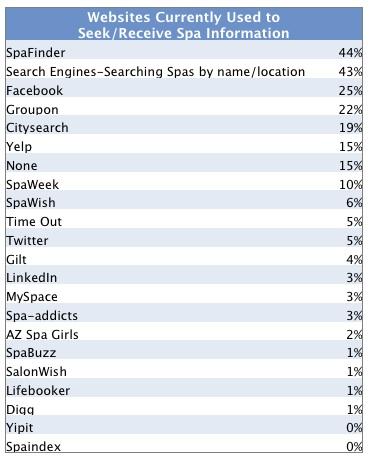In our Global Spa Survey, we asked consumers what websites they currently use to seek spa information. Respondents were asked to select all that they utilize so percentages will not add up to 100. The respondent usage was as follows:
As indicated in the table above, SpaFinder proved to be a widely known and used resource for spa consumers with 44% of respondents utilizing it. This indicates strength and trust in a well recognized and reputable spa-focused organization.
Clearly spas need a search engine optimization strategy with 43% of their potential new users pre-qualifying themselves at a search engine. Surprisingly, 15% of respondents said they used no websites to receive spa information and interestingly, these respondents were spread amongst all age categories fairly evenly.
Though usage was varied on websites such as Groupon, SpaWeek and Gilt where online auctions, coupons or date specific deals are offered; the use of these sites offers an interesting and unique dynamic. This allows a broader consumer base to sample a spa’s offerings, typically at a deep discount. Spas then rely on a strategic follow-up marketing plan, word of mouth and/or social networking to ‘spread the word’ about how great the spa experience was.
The frequent utilization of Facebook to seek spa information is also truly indicative of the power of social networking on spa marketing. Spas have been adding and updating Facebook pages to attract a new group of consumers, utilizing them to spread deals, news and other updates. Some even offer daily deals, a practice of yield management, to fill same-day gaps.
Still, despite consumers not deeming them overwhelmingly trustworthy, sites like Yelp and Citysearch are still quite prevalent in terms of those seeking and receiving spa information. Monitoring content on these sites and those like them is also another good idea.
We also asked spa goers to identify their primary purposes in visiting such sites for spa information. Respondents were asked to select all that they utilize so percentages will not add up to 100. The respondent usage patterns were as follows:
Not surprisingly, most are visiting websites to find deals. Interesting though, was that viewing spa menus was so strong. This suggests that by the time the web surfer reaches a spa site, they are demonstrating a heightened sense of commitment to make a purchase, given they are looking at the specific offerings. Also, with almost half of the respondents saying they log on to read feedback and find new spas to visit, spa owners may be compelled to secure a strong online presence.
Based upon what we learned about the categories above, we recommend the following strategies:
- Becoming search engine optimized for the terms consumers use to find spas in your geographic and demographic market
- Offering a very straightforward deal on a highly-targeted web site like SpaFinder. Benefits of this strategy include appeal and reaching a large number of people.
- Developing a social networking presence by developing a Facebook page, even a simple one.
- Monitoring feedback sites to better understand what consumers are saying to help manage the consumer web experience regarding your spa.















